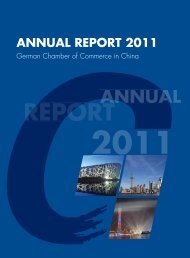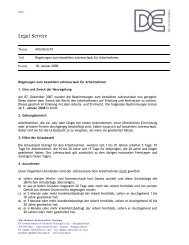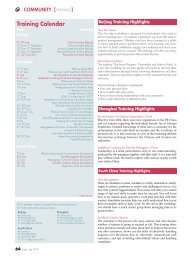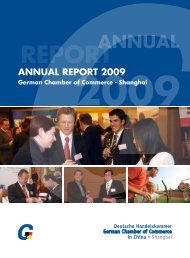Oktoberfest China - AHKs
Oktoberfest China - AHKs
Oktoberfest China - AHKs
Create successful ePaper yourself
Turn your PDF publications into a flip-book with our unique Google optimized e-Paper software.
Business Focus<br />
Sino - German Business<br />
October - November 2008 | 12<br />
The German Chamber of Commerce in <strong>China</strong><br />
Just How International is Shanghai?<br />
Shanghai has been home to residents from a wide variety of cultures<br />
and ethnic backgrounds over the last 170 years. In fact, looking at the<br />
cityscape, you could say many areas were built by expatriates. Over<br />
the years, relatively accurate records have been kept on the numbers<br />
and nationalities that have called Shanghai ‘home’ - right down to the<br />
last Albanian. Yet, at no point in the last 100 years has this number<br />
been as difficult to pinpoint as today.<br />
If one thing is certain, it’s that Germans have played an important part<br />
within <strong>China</strong>’s expatriate community, particularly in Shanghai. In fact,<br />
it’s widely acknowledged that Germans and Americans outnumber all<br />
non-Asian expats. This is no surprise, when you consider that Germany<br />
is <strong>China</strong>’s largest economic and trade partner in Europe, or that many of<br />
the largest German investors in Asia are based in Shanghai.<br />
Immigration Over the Years<br />
1865 - Out of total 2,235 international residents, 175 were German<br />
1915 - The foreign settlement and concession area housed 20,924 foreigners<br />
– predominantly British merchants, missionaries and physicians.<br />
The number of Germans had increased to 1,425.<br />
1925 - Census revealed there were nearly 30,000 foreign residents, consisting<br />
3.5% of the population. While the Japanese made up the largest<br />
group, the German population was rapidly increasing.<br />
1930 - The German expatriate community outnumbered the French, at<br />
1,430 residents throughout the International Settlement, external roads<br />
and French Concession.<br />
1934 - Shanghai was the world’s 6th largest city, with a foreign population<br />
of 70,000. Most were Japanese or Russian, but Germans still outnumbered<br />
the French.<br />
1942 - Shanghai’s pre-1949 foreign population peaked at 150,931.<br />
Snapshot of a City’s Growth<br />
In the early census days, a complete breakdown of the nationalities<br />
was available. However, today the situation is no longer clear, with a<br />
number of different authorities responsible for keeping records. These<br />
include the Shanghai Municipal Labor Bureau, the Public Security<br />
Bureau as well as the various foreign Consulates. While in the 1930s<br />
foreigners required neither visas nor passports to enter Shanghai,<br />
today’s complicated requirements span a wide range of visas and residence<br />
permits.<br />
Resident Status<br />
The F visa also known as a business visa is the case which causes the<br />
most confusion. Some ‘F’ visas holders visit <strong>China</strong> strictly to conduct<br />
business for a short period of time. They stay in hotels and don’t stray<br />
much beyond the Bund, Pudong and Yuyuan Gardens. Others remain<br />
here a little longer, and extend their stay a few times until they count<br />
essentially as residents, but how many of these cases are there? How<br />
have recent visa changes affected this group? The answer is uncertain.<br />
According to the Shanghai Municipal Statistics Bureau, by late 2006,<br />
Shanghai’s total population (not including itinerant or migrant residents)<br />
had grown to 18m. According to the Municipal Labor and<br />
Security Bureau, legally registered international residents numbered<br />
Fig. 1<br />
Japan 30% 29,326<br />
America 13% 15,877<br />
South Korea 12% 17,020<br />
Singapore 6% 6,336<br />
Germany 5% 5,636<br />
France 4% 5,437<br />
Canada 4% 4,572<br />
Australia 3% 3,927<br />
Malaysia 3% 4,097<br />
UK 3% 3,725<br />
Other 17% 23,923<br />
119,876, constituting around 0.7%<br />
of the total population, and more<br />
than 50% of <strong>China</strong>’s total international<br />
population.<br />
In mid 2006, the Shanghai Municipal<br />
Labor and Social Security<br />
Bureau announced there were<br />
51,000 foreigners working in<br />
Shanghai. (Fig.1)<br />
As these statistics reveal, ‘Western’<br />
expatriates constituted a mere 32%<br />
of the international community in<br />
Shanghai. Regional expats from Japan, Korea, Singapore and Malaysia<br />
made up 52%. There were also a further 20,000 permit holders from<br />
Hong Kong, Taiwan and Macau listed as permanent residents.<br />
If you include those working in <strong>China</strong> without a work permit (usually<br />
living here on an F visa), estimates of the total number vary greatly<br />
and rise to as high as 600,000 but this is an impossible number to<br />
validate. Since 2004, annual increases have been between 25-35%.<br />
Apparently, the long-term goal of the Shanghai Municipal Government<br />
is to establish an international community that constitutes 5% of the<br />
city’s total population. The question, nervously being asked by expatriates<br />
and other foreign residents, is will the gates be shut once that<br />
goal is reached? Recently, a tightening of F visa regulations has been<br />
one indicator.<br />
Germany in Shanghai<br />
1872 - C. Melchers & Co. enters Shanghai<br />
1885 - German Consulate General built<br />
1886 - First German business delegation in Shanghai<br />
1914 - German School of Engineering built at the Tongji University<br />
1929 - German Cultural Center established in Shanghai consisting of<br />
the German Community Center, the Kaiser Wilhelm School and the new<br />
German Protestant Church<br />
1972 - Germany established official diplomatic ties with the People’s<br />
Republic of <strong>China</strong><br />
1984 - German Business Association is founded with 13 members<br />
1986 - Hamburg and Shanghai become sister cities<br />
2000 - Trade volume between Shanghai and Germany totals USD3.6 bn<br />
2001 - <strong>China</strong> attracted direct investment from 1,600 German companies,<br />
650 of which had set up their joint ventures or representative offices in<br />
Shanghai.<br />
Second Generation Expats<br />
The majority of Shanghai’s international population consist of the<br />
employees of multinational corporations and their families. Over the<br />
last 3 years, the number of expatriate children has risen by more than<br />
30%, an increasing number of which were born in Shanghai and know<br />
no other home than <strong>China</strong>.<br />
As the number of children increases, so do the education resources<br />
and schools that cater to them. The German School Shanghai was

















